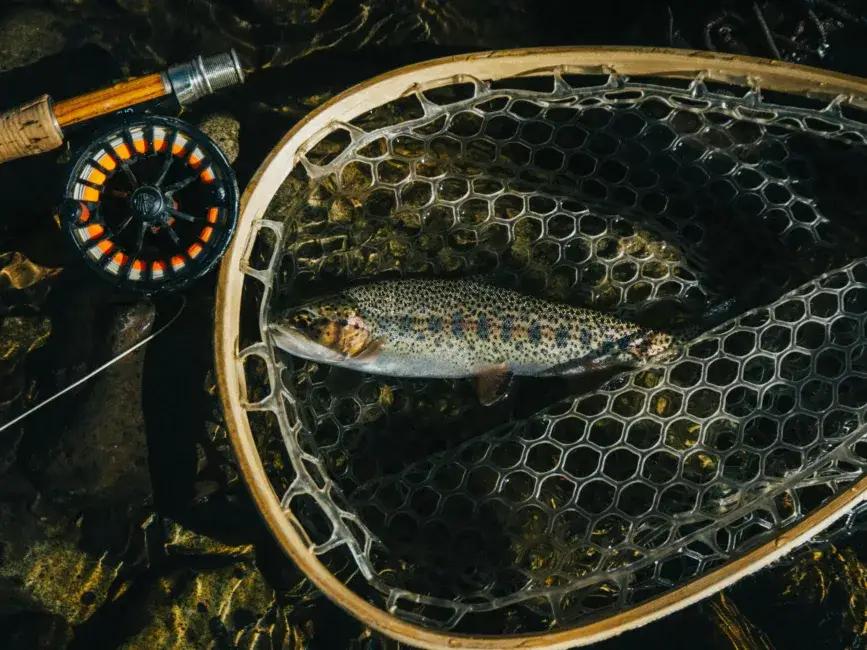Fly fishing isn’t just about casting a line into the water and hoping for the best. It’s about understanding and harmonizing with the great outdoors. Your gear is your closest ally in this adventure. We’re talking rods, reels, lines, and flies – each piece of equipment plays a critical role in your fly fishing story.
So, you’re looking for something versatile to get started? Consider this: a 9-foot, 5-weight rod and reel combo is like the Swiss Army knife of fly fishing tackle, fantastic for tackling a variety of fishing situations. It’s like having a trusty wand at your fingertips ready to work some magic on the water.
Investing in quality gear is akin to investing in success. Sure, you might have to spend a few extra dollars, but the performance and durability of good-quality equipment pay off in the long run. Think of this as setting the foundation for your fly fishing journey – strong, reliable, and primed for challenge and adventure.

In my opinion, don’t rush the process of gearing up. A fine-tuned fly fishing setup is as personal as a fingerprint, unique to you and your fishing style. So choose something that resonates with you, and remember, your first attempt doesn’t need to be your last.
A lot is happening very quickly when you step into the water, and being well-equipped is your first step to keeping up. With your gear ready, you’re set to move on to mastering the heart of fly fishing – casting.

Essential Casting Techniques for the Aspiring Angler
Proficiency in fly casting can make or break your fishing day. And that’s not an overstatement. Casting is the cornerstone of fly fishing, and while it might look like a form of magic, anyone can learn to cast like a pro with patience and practice. So, here’s the deal – I’m here to help you with the basic overhead cast, the bread and butter of fly fishing casts.
Imagine you’re painting a stroke in the air; your rod is the brush, and your line is the paint. That smooth, fluid motion of the overhead cast is key. It isn’t about muscling the line across the water – fly fishing finesse comes from the rhythm of your cast. You’ll want to start by getting the hang of this motion in an open area, free from trees and obstacles. Remember, it’s not about throwing your shoulder out, but engaging your wrist and forearm in a graceful, whip-like action.
I’ve found that timing is everything when you’re aiming for that graceful, controlled delivery of the fly. You’ll need to coordinate the movement of your rod with the unspooling of your line. This can be tricky at first, but once you’ve got it down, you’re going to love the feeling. It’s almost like conducting an orchestra – your rod guides the tempo, and the line follows your lead. So, practice this at home, and when you’re ready, take that confidence to the water.
Good casting sets you up for successful fly presentation, which I’ll get to next. Think of it this way: if casting is the opening act, presentation is the headliner of the show. It’s what actually entices the fish to bite. And to set the stage correctly, you need to be able to place your fly exactly where the fish are feeding, which is where the art of casting shines. So take your time mastering your cast – the fish are waiting, and so is the rewarding experience of a well-placed fly.

Mastering the Subtleties of Fly Presentation
Mastering the subtleties of fly presentation is a game-changer. It’s what separates novice anglers from the seasoned ones. It’s not just about placing your fly where you think the fish are; it’s about making it so irresistible that they can’t help but take a bite. You’re going to find out about the importance of presenting your fly in a way that mimics the natural movements of prey.
The key to captivating your catch is subtlety. On the water, less can be more. Whether your fly is surfing the surface tension or diving into the depths, the goal is to replicate the natural behavior of the insects or baitfish. This requires finesse and often means working with the water’s flow, letting the current guide your fly’s drift rather than relying on aggressive reeling or tugging.
Don’t worry too much about mastering every technique right away. Focus on a few simple methods first, like adjusting your casting angle to account for wind and current, or learning how to mend your line. Mending is a technique you use after your fly hits the water to extend the drift and avoid unnatural drag. These skills can make a massive difference in how your fly is received by the watchful eyes beneath the surface.
As you progress, you’ll learn there’s more to presentation than just the cast. Control is vital. Think about how you manage the fly after it lands on the water. Adjusting the speed and direction of the fly’s drift can sometimes trigger a strike from a fish that’s been ignoring your offerings. Choose something that resonates with the technique you enjoy most and build on that with practice.
Presentation isn’t about a single moment. It’s an ongoing conversation with the fish, communicating through the language of the currents and the dance of the fly. You have to anticipate the fish’s next move, adjust your strategy, and sometimes even change locations to maintain a convincing performance. Learning these nuances in fly presentation will create a solid foundation for your attempts at Reading the Water and Matching the Hatch—which I’m going to delve into next.
.
Patience and Persistence: Key Virtues in Fly Fishing
Fly fishing is a craft where patience is not just a virtue, it’s a necessity. You’re going to find out about the unwavering patience and the persistent spirit needed to truly excel in fly fishing. Rome wasn’t built in a day, and much like that adage, mastering the art of fly fishing takes time and dedication.
As you progress on your fly fishing journey, don’t worry too much about the days when the fish just won’t bite, or the casting technique seems to evade you. Remember, your first attempt doesn’t need to be your last. With each outing, aim to hone your observation skills and refine your techniques.
One of the most intriguing aspects of fly fishing is the constant opportunity for growth. Embrace every challenge as a learning experience. Adjust your approach down the road as you gain more insight into fish behavior and environmental patterns.
Choose something that resonates with you, whether it’s a serene, solitary morning on a mist-covered river or the exciting challenge of a hatch that has the fish biting non-stop. There’s a lot of opportunity in fly fishing to find moments that excite and fulfill you, both as an angler and as someone who appreciates nature.
Respect for the natural world is foundational in fly fishing. I really hope that you always remember to fish responsibly, practicing catch-and-release and handling fish with care. It’s not just about enjoying the sport; it’s also about being a steward of the environment, ensuring the vitality of aquatic ecosystems for future generations.
Finally, I’d love to hear your feedback on your fly fishing adventures. Don’t hesitate to share your thoughts or ask questions. It’s all about community and sharing the passion for this beautiful sport. Now, grab your gear, and let the adventure begin!



